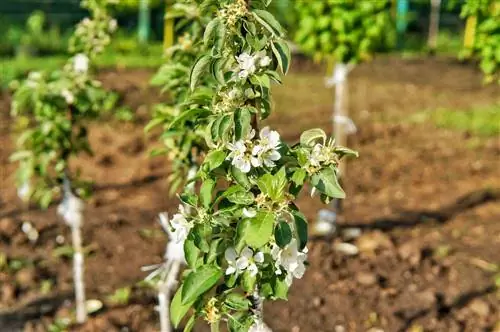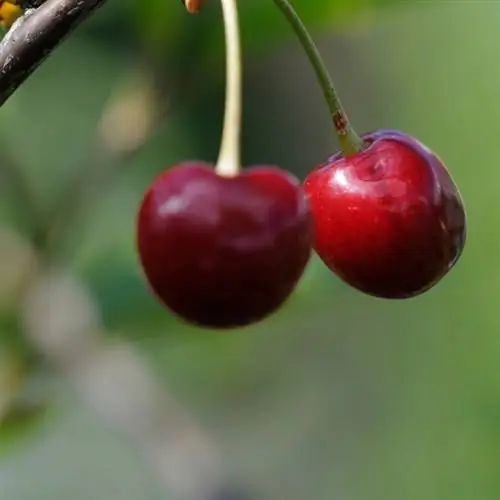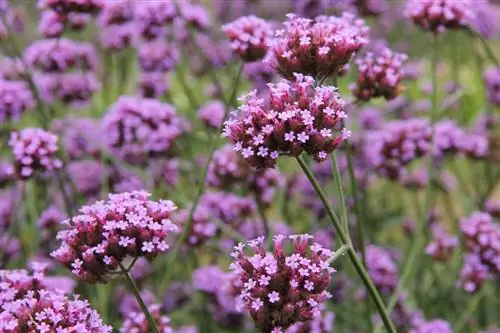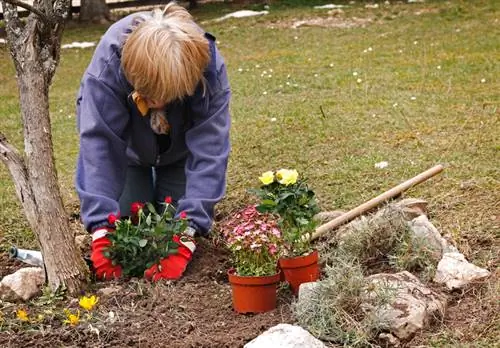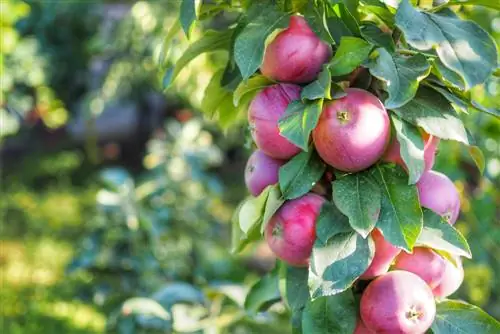- Author admin [email protected].
- Public 2023-12-16 16:46.
- Last modified 2025-06-01 06:02.
Read a commented columnar apple profile here with explanations of growth, flowers, fruits and premium varieties. Tips worth reading explain how to properly plant, care for and cut a columnar apple tree.
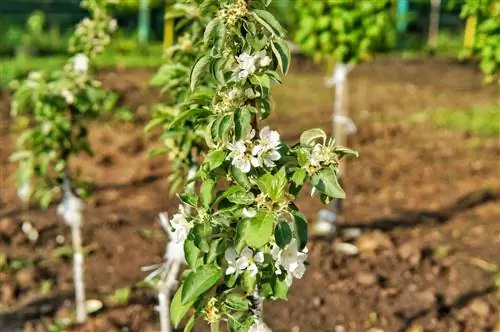
What is a columnar apple tree and what varieties are there?
Columnar apple trees are space-saving, slender fruit trees that are suitable for small gardens and balconies. They grow at a height of 150 to 400 cm and offer edible, storable fruits. Popular varieties include Rondo, Fresco, Jucunda, Gracilis, Arbat and Dulcessa.
Profile
- Scientific name: Malus domestica
- Family: Rosaceae
- Genus: Apples (Malus)
- Type: Cultivated apple with over 20,000 apple varieties
- Growth type: refined cultivated apple variety
- Growth habit: columnar
- Growth height: 150 cm to 400 cm
- Leaf: round, oval, ovoid
- Flower: umbellate panicle
- Fruit: pome fruit
- Fruit quality: edible, storable, ripening
- Use: outdoor fruit trees, potted plants
Growth
Pillar apple is a space-saving cultivation of the cultivated apple for small gardens, balconies and terraces. Refined by the hand of the master tree nursery, the fruit trees are perfect for private cultivation in confined spaces. The compact, slim appearance does not come at the expense of flower splendor and fruit quality. Facts worth knowing about the growth of an apple column:
- Growth type: deciduous fruit tree.
- Growth habit: columnar, dominant central shoot, short side shoots as fruiting wood.
- Growth height: 150 cm to 400 cm
- Growth width: 20 cm to 60 cm
- Growth speed: 5 cm to 30 cm annual growth.
- Root system: Heartroot
Video: Caring for a fruit tree as a pillar in the garden
Bloom
The flower buds are created by a columnar apple the previous year. Parallel to the emergence of the leaves, clusters of fragrant flowers develop in late spring with these characteristics:
- Inflorescence: terminal umbel with 5 to 10 individual flowers.
- Single flower: five-petaled, flat cup-shaped, 2 cm to 5 cm in diameter.
- Flower color: white or pinkish white.
- Flowering time: April and May.
- Fertilization: honey bees, wild bees, bumblebees.
Fruit
Fertilized flowers turn into appetizing dessert apples with these properties by late summer and autumn:
- Fruit type: Colloidal fruit, juicy pulp around a core of 5 chambers, each with 2 seeds.
- Fruit shape: spherical to flattened, medium to small.
- Shell: green-yellow with red cheeks, bright red to dark red.
- Fruit: depending on the variety, creamy white to reddish, firm to medium firm.
- Taste: sour, sweet-sour, sugar-sweet, typical apple aroma.
- Special properties: storable, ripening.
The ripening time depends on the columnar apple variety planted. For early summer apple varieties, the harvest season begins in August. Autumn apple varieties and storage apples ripen in September and October. In late autumn the time window opens for harvesting winter apples, which can be stored until spring.
Columnar apple tree varieties
Only selected apple varieties are suitable as columnar fruit. Based on accumulated experience, these premium varieties have emerged for cultivation as columnar apple trees in beds and containers:
| Premium varieties | Rondo | Fresco | Jucunda | Gracilis | Arbat | Dulcessa |
|---|---|---|---|---|---|---|
| Growth height | 200-300 cm | 200-300 cm | 300-400 cm | 100-150 cm | 200-300 cm | 200-300 cm |
| Fruit Color | green-yellow, red cheeks | dark red | red flamed | dark red to reddish brown | greenyellow | dark red |
| pulp | crunchy-firm | firm, juicy | biteproof | juicy-crunchy | fest | firm, fine-celled |
| Taste | sweet-sour | sour | sparkling-sweet | sweet-sour | aromatic-sweet | sweetly sweet |
| Ready for enjoyment | Sept. until February | Nov. until February | Oct. until Dec. | Sept. until Nov. | Sept. until Nov. | Oct. until February |
| Speciality | slow growth | scab resistant | scab resistant | smallest columnar apple | very slender growth habit | resistant to scab, mildew |
Usage
Advantageous possible uses make columnar apple cultivation interesting for hobby gardeners. Let the following tips inspire you on how to make a columnar apple tree useful in the garden and on the balcony:
- Privacy hedge with fruit yield in the allotment and nerd garden.
- Flowering bee pasture in the natural garden.
- Planted in rows as a decorative room divider in the park, open space and large garden.
- Snack fruit and privacy plant in a pot on the balcony and terrace.
Delicious recipes spark ideas for the culinary use of apples. Apples taste particularly good as a refreshing snack straight from the tree. In the kitchen, the tasty fruits are used as an ingredient for aromatic apple compote, delicious jam, invigorating fruit juice and fruity cakes.
Excursus
Rich apple harvest only with pollen donor
Always plant columnar apples in double packs. Cross-pollination is mandatory for every apple tree so that crisp, juicy fruits are formed. Other apple varieties are suitable as pollen donors, including magnificently flowering crabapple varieties. Busy bees and bumblebees are responsible for pollen transport and fertilization, and as a reward they feast on the nectar buffet. Hobby gardeners are advertising a bee-friendly garden to attract the winged pollinators.
Planting a columnar apple
Because columnar apples are refined, tree nurseries primarily offer the trees as potted or baled goods. With this quality you can plant the columnar fruit at any time of the year. The best time to plant outdoors is from mid-October to the end of March. Spring is a good choice for pot planting. You can find out where and how to properly plant a columnar apple tree here:
Location and soil
The informed choice of location aims to avoid late frost damage to the open flowers. These are the optimal conditions for a columnar apple tree:
- Sun to light partial shade.
- Warm and protected from the wind.
- Fresh to moist, well-drained clay soil, humus and nutrient-rich.
Planting in the bed - tips & tricks
The focus of planting is on important aspects such as the position of the grafting point, protection from wind, initial fertilization and the correct planting distance. The best planting tips for hobby gardeners:
- The still potted root ball is placed in water.
- The planting pit is twice as big as the root ball.
- As starting fertilizer, mix the excavated material with compost soil and horn shavings.
- Drive in a support post on the side of the main wind direction.
- Important: Unpot and pull apart the water-soaked root ball before planting.
- Plant the columnar apple so deeply that the grafting point is above the ground.
- Planting distance in hedge planting: 40 cm to 50 cm.
Tread the earth firmly for a good ground connection. Before watering the root disc, connect the central shoot and the support post with a coconut rope.
Planting in a pot - tips & tricks
If a columnar apple tree is cultivated in a container, the focus is on the size of the container, the quality of the substrate and protection against waterlogging. The planting technique is no different from planting in beds.
- The right bucket for a columnar apple has a capacity of 30 liters to 50 liters.
- Floor openings are essential for water drainage.
- Structurally stable pot plant soil and special organic soil for fruit trees are suitable as a substrate.
- Drainage made of expanded clay or pottery shards on the bottom of the bucket prevents waterlogging.
Place the pot on a plant roller. This ensures the necessary mobility if a change of location makes sense in winter.
Care for the pillar apple
A columnar apple is very easy to care for. While pruning the classic apple tree causes a lot of headaches for the hobby gardener, pruning the columnar apple tree does not raise any questions. There are other care measures behind this, such as water and nutrient supply or winter protection for potted plants. This is how you care for an apple columnar tree in an exemplary manner:
Cutting
It's that easy to master pruning on the columnar apple tree:
- Rule of thumb: only cut apples when necessary.
- Best cutting date is the end of February.
- Thin out dead wood and unfavorable growing branches at the base.
- Cut back all side shoots from 20 cm long to 5 cm to 15 cm.
- Cutting guide: Place the bypass scissors over a leaf or flower bud that faces outwards.
You can cut vigorous columnar fruit a second time at the end of June.
Thinning
Thinning out a heavy crop of fruit prevents the dreaded alternation. This technical term is used to describe yield fluctuations typical of apple trees. If a columnar apple bears abundant fruit in one year, it will not bloom or bloom sparsely the following year. The devastating result is a significant loss of harvest. Completely exhausted, the fruit tree simply lacks the energy reserves to produce new flower buds. This is how easy it is to solve the problem:
- The best time is the end of May to the beginning/mid-June (fruits are thumb-sized).
- Thin each fruit cluster to 1 to 2 apples.
- Pinch out the fruit to be removed with your thumb and forefinger or cut it off with pruning shears.
Care tips
- Water the columnar apple tree outdoors (€21.00 on Amazon) in the morning or evening when it is dry in summer.
- Water the potted plant regularly and thoroughly after a finger test.
- Mulching with compost stimulates the sprouting and formation of flower buds.
- Fertilize planted apple columns in March and June with compost or horn shavings.
- Fertilize potted apples monthly from March to August with organic liquid fertilizer.
Diseases and pests
These are the most common diseases and pests on the columnar apple:
- Apple scab (Venturia inaequalis)
- Mildew (Erysiphaceae)
- Codling moth (Cydia pomonella)
- Apple blossom beetle (Anthonomus pomorum)
- Appleweb moth (Yponomeuta malinellus)
Popular varieties
In addition to the premium varieties in our profile table, these modern and old columnar apple tree varieties can be discovered in stores:
- Elstar columnar apple: well-known autumn apple as a columnar fruit, golden-yellow-red peel, mildly aromatic pulp.
- Pillar apple Sonata: high-yielding variety, red-yellow, medium-sized fruits, ready to harvest from the beginning/mid-September.
- Black McIntosh: historical variety from 1811, extremely slim, reddish to purple-blue fruits with a juicy, aromatic taste.
- Pillar Apple Rhapsody: popular variety for outdoors and containers, medium-firm, creamy white flesh, height 300-400 cm.
- Pillar apple Starcats: extra hardy, space-saving apple column, 20-40 cm wide, delicious, red-cheeked fruit, stores well.
- Lopini: new variety with a short ripening period until August, red-yellow, juicy-sweet fruits as a snack directly from the apple tree.
FAQ
Where can you plant an apple tree column?
Choose a sunny to partially shaded location outdoors and on the balcony. In a warm, wind-protected place, the frost-sensitive flowers are well prepared against the risk of late frost. An apple tree column thrives in any normal garden soil that is well-drained and humic.
Is a columnar apple self-pollinating?
No, no apple tree is self-pollinating. In order to pollinate a columnar apple, at least one other apple variety in the surrounding area is required. Columnar apples of a different variety, classic apple varieties and ornamental apples are suitable as pollen donors. Bees and bumblebees also have to take care of pollination.
On what base should columnar apples be refined?
There is controversy among experts about the perfect base for columnar apples. The fact is that the rootstock chosen has a significant influence on the growth strength of the grafted apple column. The frequently used rootstock M26 supports the desired slim, space-saving growth habit. In return, a support post is required for life. Nurseries usually graft columnar apples on rootstocks MM106 and MM111 for medium to strong growth that does not require a support post.

